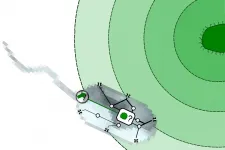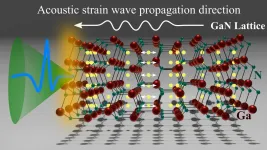The investigators, working with collaborators at the National Institutes of Health, had previously found that infrequent mild head impacts did not have an effect on learning and memory, but in their new study, reported May 10 in Nature Communications (DOI: 10.1038/s41467-021-22744-6), the investigators found that when the frequency of these non-damaging head impacts are increased, the brain adapts and changes how it functions. The investigators have found the molecular pathway responsible for this down-tuning of the brain that can prevent this adaptation from occurring.
This study is the first to offer a detailed molecular analysis of what happens in the brain after highly repetitive and very mild blows to the head, using mice as an animal model, says the study's senior investigator, Mark Burns, PhD, an associate professor in Georgetown's Department of Neuroscience and head of the Laboratory for Brain Injury and Dementia.
"Most research in this area has been in mouse models with more severe brain injury, or in human brains with chronic traumatic encephalopathy (CTE)," he says. CTE is a degenerative brain disease found in people with a history of repetitive head impact. "This means that we have been focusing only on how CTE pathology develops. Our goal was to understand how the brain changes in response to the low-level head impacts that many young football players, for example, are regularly experiencing."
Researchers have found that the average high school and college football player receives 21 head impacts per week, while some specialized players, such as defensive ends, experience twice as many. Behavioral issues believed to come from head impact have been reported in athletes with exposure to repeated head impacts. Issues range from mild learning and memory deficits to behavioral changes that include aggression, impulsivity and sleep disorders.
"These findings represent a message of hope to athletes and their families who worry that a change in behavior and memory means that CTE is in their future," says Burns.
In this study with mice, researchers mimicked the mild head impacts experienced by football players. The mice showed slower learning and impaired memory recall at timepoints long after the head impacts had stopped. After the experiment, a detailed analysis of their brains showed that there was no inflammation or tau pathology, as is usually seen in the brains of brain trauma or people with CTE.
To understand the physiology underlying these memory changes, the study's co-first author, Bevan Main, PhD, assistant professor of neuroscience at Georgetown, conducted RNA sequencing of the brain. "There are many things that this type of analysis can point you to, such as issues with energy usage or CTE-like pathways being activated in nerve cells, and so on," Main says. "All of our sequencing studies kept pointing to the same thing - the synapses that provide communication between neurons."
The next step was to figure out how synaptic function was altered. Stephanie Sloley, PhD, a graduate of Georgetown's Interdisciplinary Program for Neuroscience and the study's other first co-author, conducted electrophysiology studies of different neurons charged with releasing varied neurotransmitters - chemicals passed between neurons, via synapses, that carry functional instructions. "The brain is wired via synaptic communication pathways, and while we found that these wires were intact, the way that they communicated using glutamate was blunted, repressed," says Sloley.
Glutamate is the most abundant neurotransmitter in the brain, and is found in more than 60% of brain synapses. It plays a role in synaptic plasticity, which is the way the brain strengthens or weaken signals between neurons over time to shape learning and memory.
"Glutamate is usually very tightly regulated in the brain, but we know that head impacts cause a burst of glutamate to be released. We believe that brain is adapting to the repeated bursts of glutamate caused by high frequency head impact, and dampens its normal response to glutamate, perhaps as a way to protect the neurons," explains Sloley. She found that there was a shift in the way that neurons detected and responded to glutamate release, which reduced the neurons ability to learn new information.
With a single head hit or infrequent hits, the synapses do not go through this readjustment, Burns says. But after only a week of frequent mild hits, glutamate detection remained blunted for at least a month after the impacts ended. The affected mice showed deficits in learning and memory, compared to a placebo group of animals.
The authors confirmed that the changes in cognition were due to glutamate by giving a group of mice a drug to block glutamate transmission before they experienced the series of head knocks. This drug is FDA-approved for the treatment of Alzheimer's disease. Despite being exposed to the hits, these mice did not develop adaptations in their synapses or neurotransmission, and did not develop cognitive problems.
"This tells us that the cognitive issues we see in our head impact mice are occurring due to a change in the way the brain is working, and not because we have irreparable brain damage or CTE," Main says. "It would be very unlikely that we would use a drug like this in young players as a neuroprotectant before they play sports, because not all players will develop cognitive disorders," he says. "More much likely is that we can use our findings to develop treatments that target the synapses and reverse this condition. That work is already underway"
Burns believes that CTE and this newly discovered mechanism is different. "I believe that CTE is a real concern for athletes exposed to head impact, but I also believe that our newly discovered communication issue is independent of CTE. While it is concerning that head impacts can change the way the brain works, this study reveals that learning and memory deficits after repeated head impacts do not automatically mean a future with an untreatable neurodegenerative disease."
INFORMATION:
This work was supported by the National Institutes of Health (NIH) / National Institute of Neurological Disorders and Stroke (R01NS107370 & UG3NS106941), the National Institute of Diabetes and Digestive and Kidney Diseases (R01DK117508 to S.V.), and the National Institute of Aging (R03AG061645). NINDS also supported the Neural Injury and Plasticity Training Grant in the Center for Neural Injury and Recovery at Georgetown (T32NS041218). Funding was also provided by the Advanced Rehabilitation Research and Training Fellowship funded by the Department of Health and Human Services (90AR5005).
The authors report having no personal financial interests related to the study.
About Georgetown University Medical Center
Georgetown University Medical Center (GUMC) is an internationally recognized academic health and science center with a four-part mission of research, teaching, service and patient care (through MedStar Health). GUMC's mission is carried out with a strong emphasis on public service and a dedication to the Catholic, Jesuit principle of cura personalis -- or "care of the whole person." The Medical Center includes the School of Medicine and the School of Nursing & Health Studies, both nationally ranked; Georgetown Lombardi Comprehensive Cancer Center, designated as a comprehensive cancer center by the National Cancer Institute; and the Biomedical Graduate Research Organization, which accounts for the majority of externally funded research at GUMC including a Clinical and Translational Science Award from the National Institutes of Health. Connect with GUMC on Facebook (Facebook.com/GUMCUpdate), Twitter (@gumedcenter).


